Small-Scale Food Production and the Impact of Water Shortages in Puerto Rico After Hurricane Maria
An Early Status Assessment
Publication Date: 2018
Abstract
After Hurricane Maria, many Puerto Ricans lacked electricity and access to potable water. The emergency response and recovery efforts were severely hampered by damaging economic and environmental policies, resulting in substantial deferred maintenance to infrastructure, a disappearing tax base, and a major debt crisis. We traveled to agricultural sites across Puerto Rico to examine the impacts of the hurricane on the stability and potential for growth of food security and food sovereignty initiatives. We spoke to residents, small business owners, and those working in the recovery efforts, gaining a broad sense of short- and long-term concerns and challenges to community initiatives. Paradoxically, persistent inconsistencies in resource valuation, licensing and distribution in Puerto Rico have created opportunities for powerful and deeply-rooted local responses to flourish, but structural inequities must still be addressed in far more systematic ways. Our research shows that people with direct access to land and clean water sources are better able to sustain themselves nutritionally in times of social breakdown that result from natural disasters and subsequent difficulties, such as road blockages, lack of electricity, lack of access to food stores, and communications failures. Yet, people in rural areas are also less likely to receive immediate attention in recovery efforts.
Introduction
In the wake of Hurricane Maria’s landfall, significant numbers of Puerto Ricans lacked electricity and access to potable water. Months after the storm, residents continued to experience major disruptions to infrastructure and housing. The emergency response and early recovery efforts were severely hampered by damaging economic and environmental policies, resulting in substantial deferred maintenance to infrastructure, a disappearing tax base, and a major debt crisis. The post-Hurricane Maria reality in Puerto Rico is that infrastructure needs to be rebuilt almost from scratch, including the existing agricultural system, which provides approximately 15 percent1 of the local food supply and has experienced broad and large-scale destruction. Many agricultural sites are located in remote areas across Puerto Rico, including the island municipalities of Vieques and Culebra, where months after Maria, roads were still being cleared and repaired.
We traveled to several remote agricultural sites across Puerto Rico to examine the immediate impacts of the hurricane on the stability and potential for growth of food security and food sovereignty initiatives. These farms and educational initiatives were in existence before Maria made the need for reliable, safe, and renewable sources of water, food, and electricity so salient. Yet, resilient and sustainable systems are more crucial now than ever before, as adverse political and economic conditions persist (for example, through restrictive shipping laws.) We also spoke to many residents, small business owners, and those working in various sectors of the recovery effort, gaining a broad sense of short- and long-term concerns and challenges related to these basic needs, as well as long-term recovery goals and aspirations.
In the period since this pilot research was undertaken, it has also become increasingly clear that suspected inequality in resource allocation and distribution between Puerto Rico and other hurricane-affected sites (particularly those hit by Hurricane Harvey) was and continues to be the norm (Vinik 20182). These material and structural inequities have paradoxically created some social opportunities for deeply-rooted local responses to flourish, but those inequities themselves must still be addressed in more systematic ways before resiliency can be said to exist at a general scale. Economically and politically, Puerto Rico remains in crisis. Even as the natural environment rebounds and social bonds are in some cases renewed through shared struggle, the overall picture for the island is not very heartening. However, as our research shows, people with direct access to land are better able to sustain themselves nutritionally in times of social breakdown resulting from natural disasters, such as road blockages, lack of access to food stores, and communications failures. Yet, people in rural areas are also particularly vulnerable in crisis situations and are less likely to receive immediate attention and recovery response from government sources than people in San Juan or other urban areas.
Research Questions
Our overarching research questions were: How are food producers maintaining or rebuilding sustainable food systems and forging new economic and agricultural practices in the aftermath of Hurricane Maria? What resources are they making use of, and what are the barriers to their progress? Through open-ended interviews and participant observation, we sought to document the immediate work of key actors and nodes involved in the food system, initially focusing on farmers and members of community-based organizations working to stabilize the food and water supplies in their communities. We documented damage to local agricultural sites and the ongoing recovery process through digital photography, participant observation (including volunteering), unstructured interviews, and the taking of samples of local and agricultural water supplies (both tap water and alternative water supplies accessed locally that are viewed by the community as more viable than water provided by municipal sources). This study, in both the short and long term, speaks directly to the intersection of the urgent theoretical and practical concerns of human and ecological health in relation to ‘green’ neo-liberalism (Goldman 20053). Engaging with material and symbolic practices of decolonization we documented the resilience of some of the most vulnerable communities.
Methods
Maria on small farms and small-scale agro-ecology projects. We talked to farmers, community members, activists, educators, and people involved in community recovery efforts about the potential for increased stability and growth of existing and future food security and food sovereignty initiatives. We also spoke to residents, small business owners, organizers, and recovery experts, gaining a broad sense of short and long-term concerns and challenges to community initiatives through informal conversations and participant observation. We took significant numbers of photographs, visually documenting the various states of recovery. We then compared field notes, identifying key themes and topics that repeated across contexts, as well as some of the specific concerns of farmers and situated knowledge shared by particular respondents. This preliminary research set the stage for potentially much deeper engagements with Puerto Rican efforts to recover from the 2017 hurricane season and to construct a better future for Puerto Rico.
Results
Food
Food has been of great material and symbolic importance for Puerto Ricans, both before and following Hurricanes Irma and Maria. In material terms, we encountered people, particularly in remote locations such as the mountain towns of Utuado and Adjuntas, who were hungry and had limited access to nutritious foods. In other areas, such as town centers, we found that some traditional, local eateries were functioning normally. In symbolic terms, the social meanings of being able to feed oneself and one’s family were intensified following the destruction caused by the hurricanes.
We also found that community-based organizations and cooperatively-minded farmers and activists in many areas were focused on creating systems for sharing the food that was available (through both local production and other sources). These were projects of which we had some knowledge through remote contact, but this fieldwork allowed us to gain a much fuller sense of the barriers to nutrition and opportunities for community solidarity that are at stake. We were also able to witness first-hand several problems with the food distribution that was part of the state-managed emergency response efforts through FEMA and military units.
Production
Prior to the 2017 hurricane season, Puerto Rico was experiencing what some called a “renaissance” of agricultural production, both in food and other commodities (such as coffee and sugar) (Charles 20174). While a number of these efforts were financed by outside investors in ways that risked reproducing the extractive economic model of capitalism that has long characterized the Puerto Rican export-led economy, our focus was on community-based farms, driven by models or at least aspirations of cooperative and sustainable production. It is our contention that long-term food sovereignty, that is, a network of autonomous food systems not reliant on foreign capital will be the most sustainable and resilient mode of food production for most Puerto Ricans, particularly in the current context of rapid global climate change and perceived risk by outside investors.
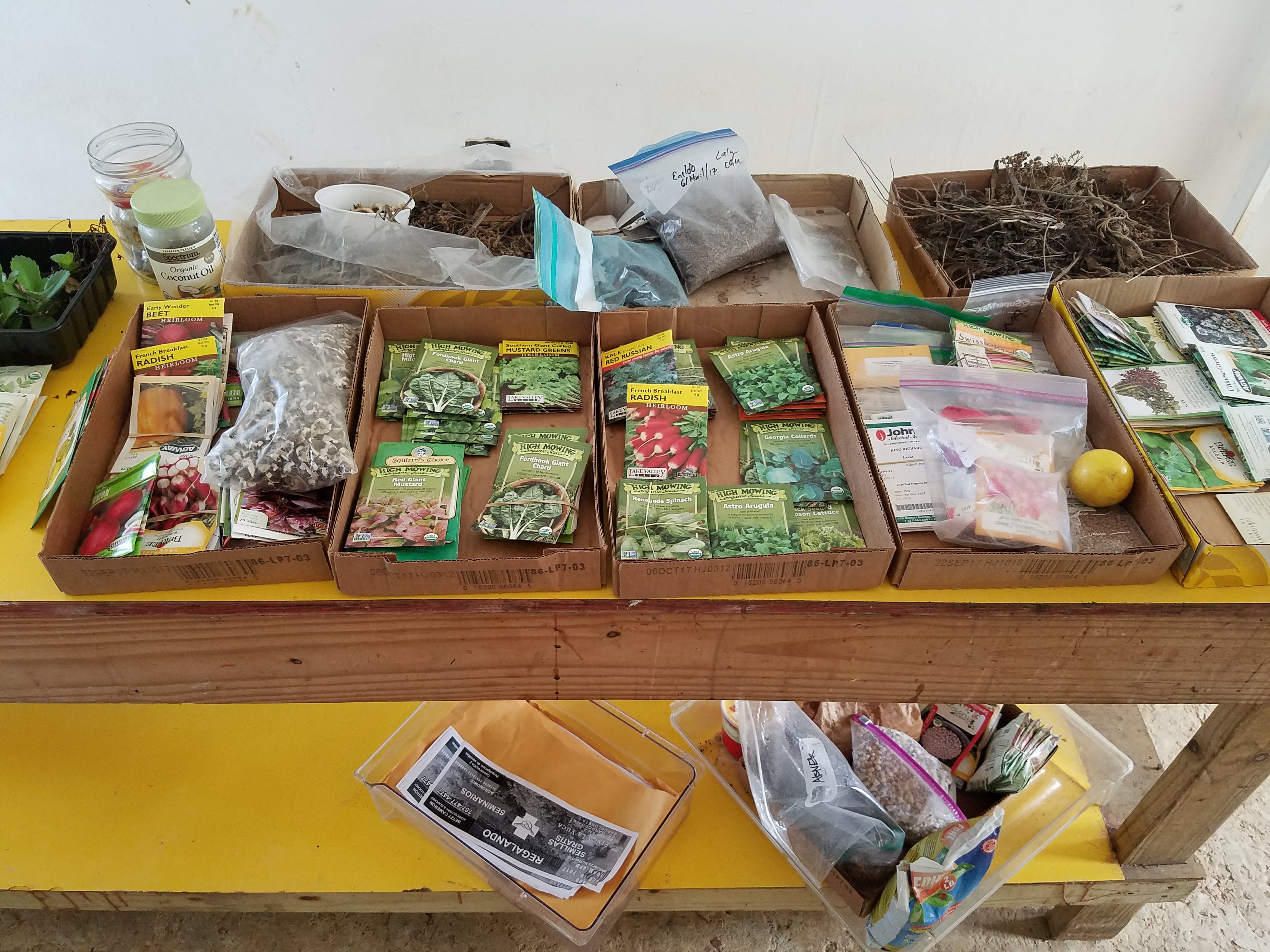 A table full of seeds waiting to be planted by volunteers at a small farm in Barceloneta. Adriana Garriga-López, 2017.
A table full of seeds waiting to be planted by volunteers at a small farm in Barceloneta. Adriana Garriga-López, 2017.
The locally-focused producers we interviewed are working to promote cooperative models of production, and this approach is somewhat in conflict with “back to the land” projects of earlier eras. These earlier jibarismo movements, characterized by ideals of stoic individualism and rugged creole masculinity continue to have a nostalgic appeal for some farmers promoting local, agro-ecological food production. As such, there is some potential conflict for resources between farmers who are comfortable with individual ownership models and collectivist models of food justice or food sovereignty, as individual farm owners are likely to be more appealing recipients of outside investment funds in a neoliberal model.
Additionally, in areas where outside investment is a dominant force in the local economy, there is a strong influence of policies promoting investment capital with preferential treatment of non-Puerto Rican investors and home-buyers. While investment or purchasing of property as a non-Puerto Rican is not inherently problematic, we found that in some communities where this pattern is growing, the outcome is the political and economic marginalization of Puerto Ricans and those who value the community’s history, language, and culture. For example, rather than learning Spanish, English-speaking residents and investors insist, sometimes aggressively, on conducting public meetings in English, with no regard for the dominant language of those who have long lived there. This trend dovetails in potentially very destructive ways with the promotion of investment by those looking to buy land cheaply with foreign capital for profit-making ventures, rather than engaging in economic activities that support community flourishing, agro-ecological food farming, and environmental remediation.
Other concerns for food producers include climate change, and in some locations, very serious drought conditions. Small-scale farming in Puerto Rico takes place across a range of climatic zones, from very dry locations in Vieques and the southern side of the big island, to perpetually rainy zones in the northern coast. As such, these potential food producers must manage ambient water, in both large and small quantities, in a more significant manner than simply watering their crops. Extreme periods of drying or drought, as some areas in Puerto Rico have experienced, particularly since 2014, can cause crops to be abandoned or certain areas of land to fall into disuse. Three of the farmers we spoke with were in the process of building rain catchment systems, one of which had been previously destroyed by Hurricane Maria.
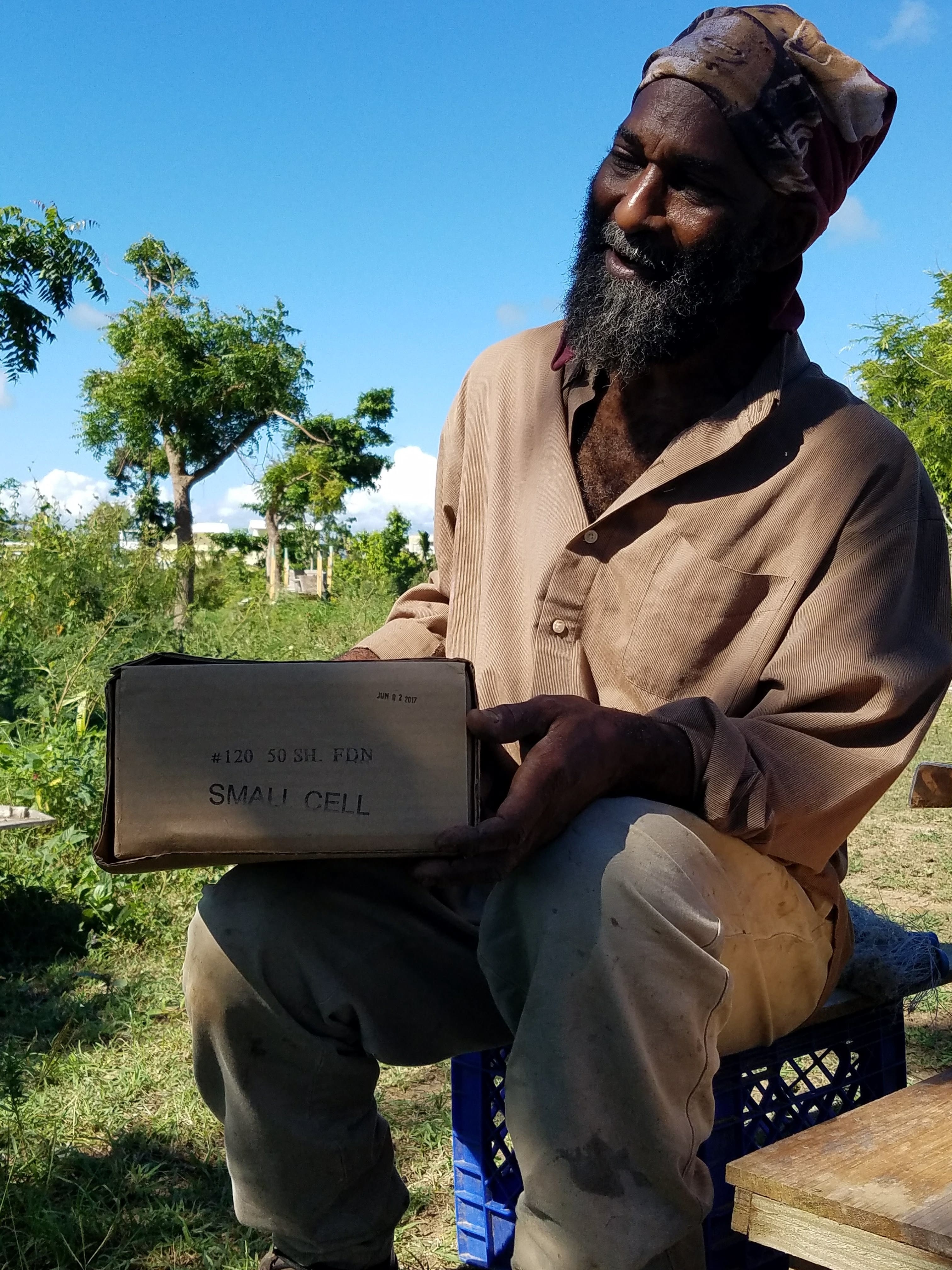 A beekeeper in Vieques, a small island off the eastern coast of Puerto Rico. Adriana Garriga-López, 2017.
A beekeeper in Vieques, a small island off the eastern coast of Puerto Rico. Adriana Garriga-López, 2017.
We also witnessed the destruction of many greenhouses across the big island and Vieques, a situation which compounded the loss of crops by severely delaying the process of replanting as most seedlings were also lost, and there has been a significant delay in the ability to begin growing new ones. Although many farms have started to rebound and rebuild crops and other assets, such as bee colonies , the crisis resulted, for one, in the importing of plantains from neighboring Dominican Republic for Puerto Rican markets that previously sold mostly locally farmed plantains. The long-term impact on the plantain and other staple markets is as yet unclear. As local Puerto Rican producers rebound from Maria’s impact, it remains to be seen whether foreign produced plantains will continue to dominate this staple crop market or if local producers will regain the ground lost after the 2017 hurricane season (Irizarry Álvarez 20185).
Many farmers conduct outreach in their communities and on social media, attempting to bring potentially interested community members to their farms and gardens to learn and help with cooperative farming activities. We were able to see some particularly effective combined food-sharing and natural health education activities. As one local activist told us, among their goals was also to encourage the creation of new rituals around food and community, and to support growing interests in more natural approaches to diet and healing, which could be supported by bringing to light the deep knowledge bases that already exist within their own communities and re-valorizing formerly marginalized ancestral knowledges. Notable at these events was the significant presence of older adult Puerto Rican women, including black or Afro-Puerto Ricans, who shared recipes, remedies, and stories about or knowledge of the use of plants and herbs. There was also a noticeable presence of English-speaking U.S. Americans who did not share the same generational knowledge of local plants and the environment, but some of whom have experience with organic farming and homeopathy. Palpably, there was some implicit conflict between these groups, though they were also working together in some ways.
Community-based food sharing and education
As one participant in our study told us, we might hear people speaking of the work as if it were a movement, “but it’s not a movement, it’s a project.” This farmer argued that for it to be a movement would require greater consensus among practitioners and broader support for the principles of agroecology. Continuing this theme, she told us that there is an opening now, as the precariousness of Puerto Rico’s situation has been increasingly revealed by the debt crisis and the hurricanes, especially in the area of food insecurity. On the other hand, most people in Puerto Rico do refer to the broadening base of small agroecological farms as a movement in part because it correlates with renewed public interest in farming and food autonomy given the alimentary shortages many people experienced during the aftermath of Hurricane Maria. However, there are a range of actors with the potential to take up space and resources in the arena of farming and ecological resources through the discourse of sustainability, and there is concern that resources might flow into projects that are labeled “eco-friendly“ or sold as “green” but do not actually serve the community or that result in increased restrictions of access to natural resources. Furthermore, the agroecology movement such as it exists does show some fragmentation in terms of different approaches, social orientations, aesthetic preferences, and philosophy of activism.
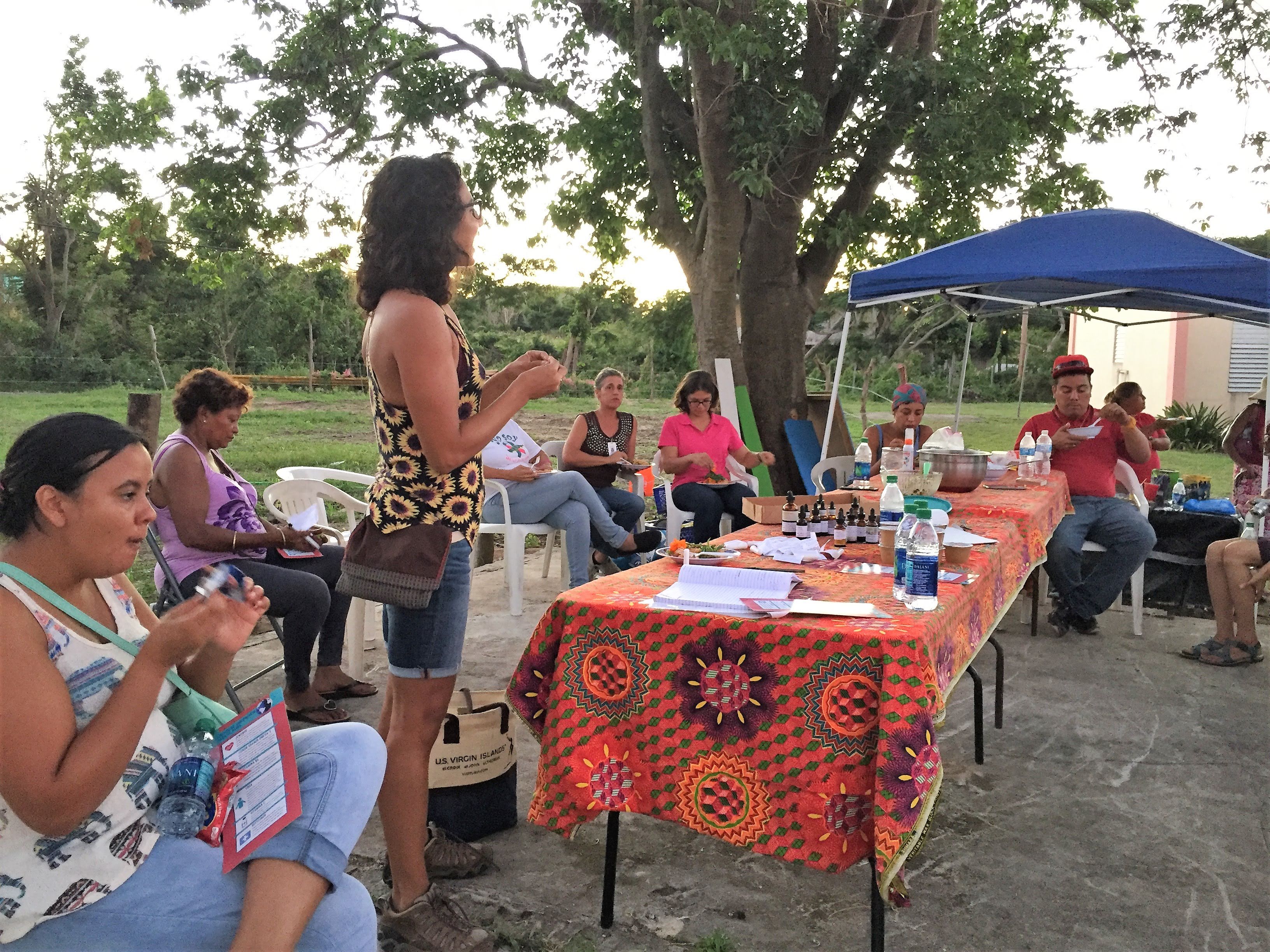 Community members meet to discuss natural healing and plant medicine in Vieques. Adriana Garriga-López, 2017.
Community members meet to discuss natural healing and plant medicine in Vieques. Adriana Garriga-López, 2017.
We learned of several approaches to raising awareness around sustainable agriculture, including a number of education-oriented projects that have the potential to grow the movement toward participatory food production and community health awareness. Some of these activities are co-planned with social eating events, in which farmers and local activists prepare food for any community member who comes to the event. At one such event we attended, the organizers brought a speaker who gave a presentation about natural healing and led a conversation encouraging the participants (approximately 35 local residents) to speak about plant-based remedies they knew about and where they had learned to use them. The conversation was not only educational, but also provided an opportunity for the attendees to appreciate the deep collective knowledge base of their families and communities. In a context where people are experiencing profound economic loss and long-term stress, activities like these provide an environment for recuperation and hope and are supportive of community mental health, as well as nutrition and greater appreciation for the natural and cultural environment.
First response provisions from government sources
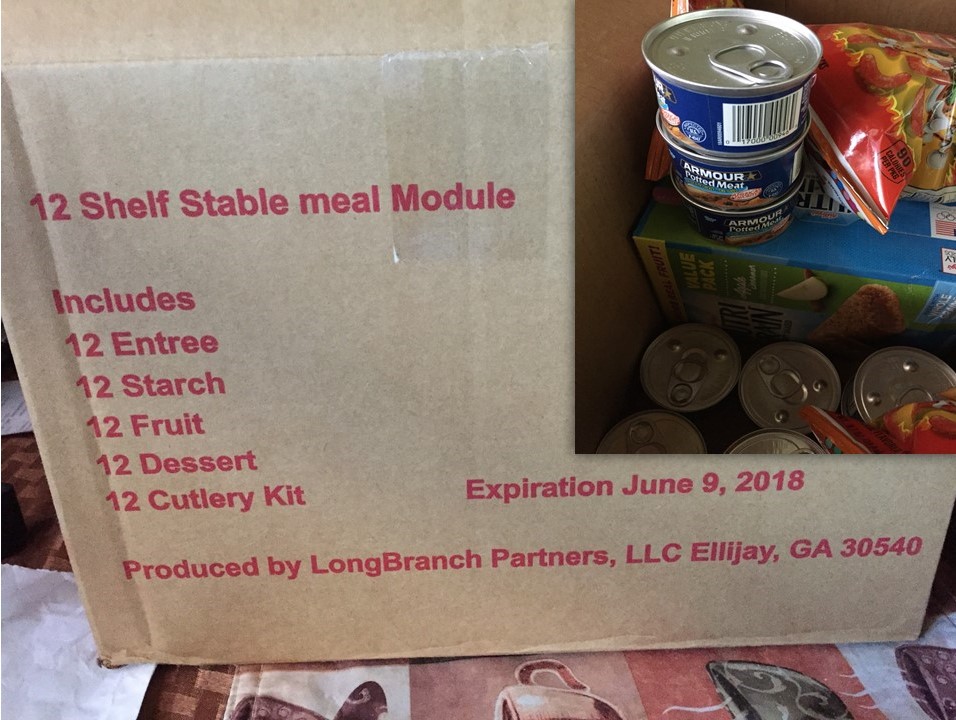 A box of shelf-stable “meals” distributed by recovery agencies; inset with contents. Alexa Dietrich, 2017.
A box of shelf-stable “meals” distributed by recovery agencies; inset with contents. Alexa Dietrich, 2017.
Finally, with respect to nutrition, we made a number of observations about the experiences of people with respect to the food provided during the ongoing emergency stage following Hurricane Maria. While reports from responding agencies continue to focus on numbers of “meals” delivered6, there has been insufficient attention paid, apart from some reports in social and traditional media, to the nutritional value of the supplies that were distributed to people in need. These consisted almost exclusively of high fat and high sodium products, items that are “shelf stable” but that cannot, in good conscience, be considered meals . Even as it may be understandable that in the “emergency” phase of a few days the priority may be calories and survival, as time drew out, Puerto Ricans found themselves in a peculiar set of contradictory emergency and recovery situations. That is, many people were lacking basic services, yet needing more than just survival supplies. What people needed and devised in Puerto Rico in the months after Maria were adaptive technologies and collaborative strategies that could help communities survive and begin to rebuild together. People were highly frustrated with the lack of state assistance and ready to move beyond a survival mode of existence.
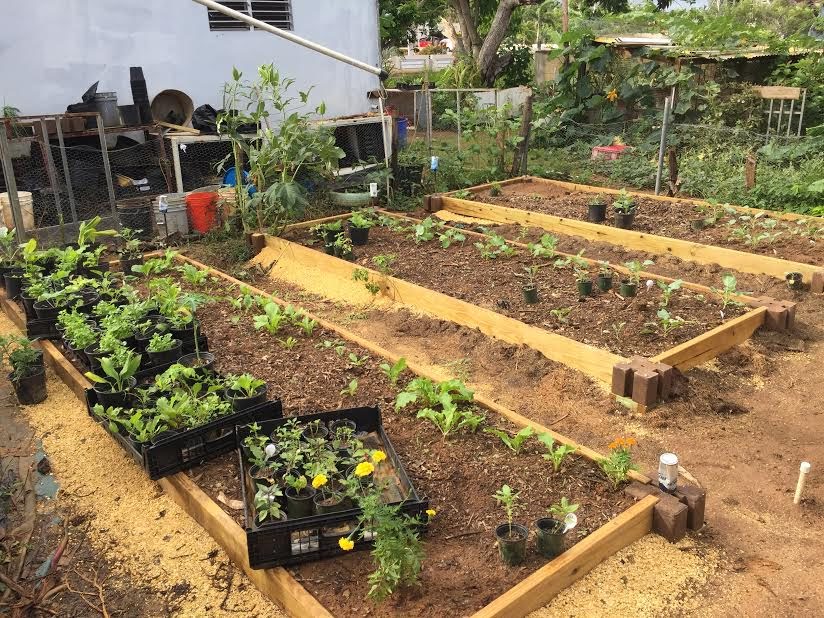 Replanting beds on a small farm in Barceloneta, north coast. Alexa Dietrich, 2017.
Replanting beds on a small farm in Barceloneta, north coast. Alexa Dietrich, 2017.
The relief food supplied to people intersected with existing health circumstances and concerns also documented in the Behavioral Risk Factor Surveillance System (BRFSS) data, namely that self-reported hypertension (42.2%) is substantially higher in Puerto Rico than the national prevalence (30.9%) (CDC 20157). While some self-report statistics may not accurately represent behavior, in this case self-reporting is a good proxy for clinical diagnosis (as people are unlikely to self-diagnose hypertension). Likewise, according to the BRFSS data, Puerto Rico has one of the highest rates of people receiving advice and taking action to address hypertension, a tendency which we observed in many conversations with people over their concern with the nutritional content of the food rations. Several people asked us rhetorically, “Are they trying to kill us?!” While this may sound hyperbolic, it must be interpreted within the context of the longstanding colonial relationship to the United States, a nation that has used Puerto Rican shores for bombing practice, and where U.S.-based companies have long polluted the air and water with little concern for the health of local residents. Other people we spoke with were worried that chronic ailments like diabetes and HIV would get worse as a result of impoverished nutrition. Although many people had better access to food supplies by the time of our visit, in some locations we still found people sheltering under heavily damaged roofs with little or no food, and unable to reach other means of assistance.
Water
What we found in terms of water use is somewhat more difficult to assess. While most people we spoke with had access to tap water, it was intermittent, and without exception people were concerned about water quality and contamination. These concerns must be understood in the context of pre-storm reports that the majority of tap water in Puerto Rico was already going untested and there was extended drought with subsequent long-term rationing in 2015. Among those water sources that were being tested before Hurricane Maria, research by the National Resource Defense Council found Puerto Rican water had the highest rate of drinking water violations in the US. It was estimated in May of 2017 (Allen 20178) that more than 2.4 million people in Puerto Rico were getting water from systems which contained harmful bacteria or other contaminants. Additionally, few municipal water systems were testing for lead contamination. Following the complete collapse of the electrical grid in September 2017, water was not arriving to taps where electricity was needed to pump the water through the system, and the water that was arriving was acknowledged by the local water company to be inadequately treated. Many people we talked to reported boiling tap water to be safe.
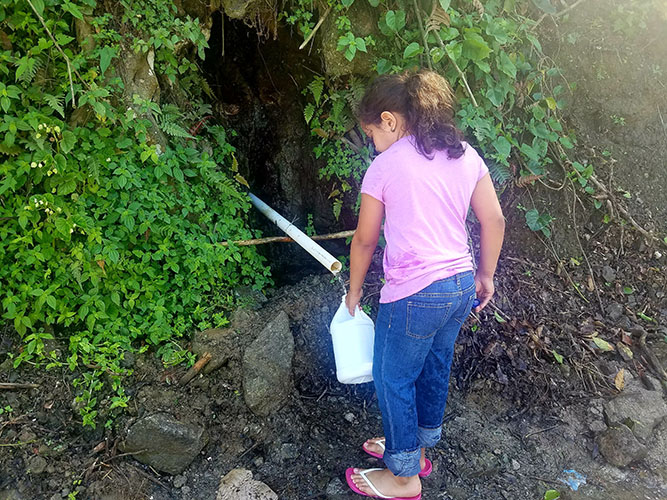 A girl collects water from a roadside spring in Adjuntas. Adriana Garriga-López, 2017.
A girl collects water from a roadside spring in Adjuntas. Adriana Garriga-López, 2017.
In some cases, water was being collected by residents at point sources long used by the community for clean water, such as one site we visited in Utuado and another in Adjuntas (see photo 7). We also tested a range of tap water samples for the most basic parameters (such as total dissolved solids and pH). While these measures were generally within acceptable levels for drinking water, this can only indicate a relatively low likelihood of some chemical or heavy metal pollution. These measures are not indicators of bacterial contamination, which previous data and ethnographic evidence suggest is probable.
In our conversations with most of our contacts across all levels of Puerto Rican society, perception of risk for consuming contaminated water was high, and most people were actively filtering water. Many were endeavoring to set up long term water filtration systems in their homes and farms, as they anticipated the need for water would continue indefinitely into the future. However, it was unclear if the filters they were using were more apt for chemical versus bacterial filtering, as these types of filters tend to be distinct. When filter distribution had occurred through donations, people likely had access to bacteria-targeting filters. If not, filters were more likely to be more readily available filters that target chemical and particle contamination, given that bacterial filters (such as those used for camping and drinking from water sources in the environment) are considered specialty items. Fears of bacterial contamination were not unfounded. As reports of research conducted after Maria show (Panditharatne 20179), the majority of the population is at risk of exposure to bacterially contaminated water.
Lastly, Hurricane Maria changed the coastal geography and affected vulnerable karst aquifers (Laskow, 201810). Initial reports show that while the aquifers were affected by the events of the 2017 hurricane season, they are quite resilient given the porous nature of the subsoil. However, for the same reason, they are also very vulnerable to contamination from industrial sources. Many contamination concerns involved the company AES, which has several sites on the south side of the main island. AES has accumulated more than 400,000 tons of coal ash at their Guayama site and has disposed of some of their industrial waste (a mix of coal ash and other chemicals) at a municipal dump in the town of Peñuelas. Despite clear evidence of negative health effects on residents living near these sites, as well as repeated protests and confrontations between police and angry residents, the Environmental Quality Board in Puerto Rico has not intervened. The Center for Investigative Journalism reported on March 15, 2018, that four experts it consulted concluded that AES is releasing “large quantities of chemicals into the groundwater and that the contamination is already migrating, including moving toward the ocean,” (Alfonso 201811). Some of the people we talked with in Puerto Rico worried about the possible effects of such contamination on highly vulnerable karst ecosystems.
Concerns about the long-term management and health of water systems and waterways in Puerto Rico is widespread, considering that knowledge about active contaminants and industrial pollution is not relegated solely to academic publics. Many people in Puerto Rico are worried about the quality of the water they consume and come into contact with.
Land, shelter, and other resources
With respect to damage to and recovery for land and shelter, both material and symbolic aspects of aid and attention were serious concerns for those we met and spoke with. As has been frequently reported in the news media, people we spoke with, particularly in municipalities outside the metropolitan area, reported receiving little assistance or attention from agencies that responded to the disaster. They were most likely to have received food, solar lights, and bottled water from other institutions, such as community-based organizations or from friends and neighbors. While local community-based organizations are typically better at reaching people outside the town centers, distribution of resources was still very challenging. In an interview at a community-based organization in Adjuntas, one organizer described their successes and difficulties. In particular, she emphasized that the need for supplies, such as solar lights, was so great that they often fell short of even formulating a distribution strategy, and at times resorted to handing out available supplies to the first people they encountered.
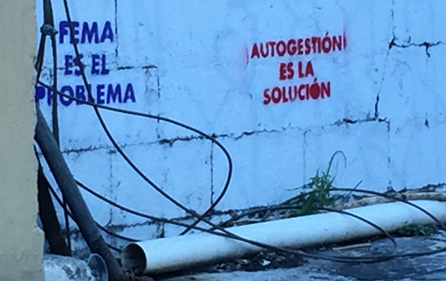 "FEMA is the problem, self-directed action is the solution." Stencil paintings on a wall in Isla Verde, San Juan. Alexa Dietrich, 2017.
"FEMA is the problem, self-directed action is the solution." Stencil paintings on a wall in Isla Verde, San Juan. Alexa Dietrich, 2017.
As has also been widely reported, people were typically directed to file claims with the Federal Emergency Management Agency (FEMA) via telephone or internet, actions often made impossible by lack of access to those resources. We also encountered people struggling with difficulties in filing those claims, once they did have access to the internet or telephone, due to problems with property titles. In some cases, homeowners did not have title to the property. In other cases, renters could not access resources to repair their residences because the landlord either did not have title to the land or did not want to file claims for various reasons. One family we spoke with believed that their landlord (who rented out a small compound of houses in the mountainous area above Utuado) refused to have representatives from FEMA evaluate the damages to the property because of concerns over a lack of building permits for the homes and/or other issues related to illegal construction. We saw a number of properties still heavily damaged by the hurricane, in some cases where tarps could not be used to cover a damaged roof, but where they could only be used to create a lean-to shelter from the wall that remained standing. In numerous cases, people reported they had given up on waiting for assistance from FEMA and had scavenged materials to repairs roofs or otherwise endeavored to recover on their own.
In the case of one community we visited in the southern part of the island, neighbors reported that residents who were former employees of the Puerto Rico Electric Power Authority, electricians, and those with construction experience were working in crews to repair downed power lines and posts themselves. These efforts were independent of any official crews or brigades but were effective in restoring power in some communities (Associated Press 201812).
Possible Applications of Results
Organizing
We found that while sustained access to electricity continued to be a challenge, many of the people we spoke with were somewhat successful at using social media to spread the word about their efforts and to engage their communities. The use of social media supplemented the “shoe leather” organizing efforts of these activists to a significant degree, and future research and recovery efforts need to pay close attention to the role of both types of activities. Unequal access to the internet and digital resources is sure to have increasingly large effects on what efforts are able to garner global attention and support. The role of social media in generating active support from the Puerto Rican diaspora and people around the world who were concerned and mobilized on behalf of Puerto Rico’s recovery also bears further study.
Gender and Sexuality
During our visits with Puerto Rican farmers and agrarian communities in December 2017, we noted marked gender scripts that played out in relation to the different meanings of food, farming, and cooking in Puerto Rican culture. These gendered ‘scripts’ were also articulated through different conceptualizations of the agro-ecological project on the islands. Further research is needed to elucidate the ways that feminism and queer epistemologies have shaped contemporary farming practices in Puerto Rico. Indigenous Taíno and Afro-Caribbean symbols and rituals also commingle with new age or ‘alternative’ practices in these spaces. Feminist critiques of nationalism, capitalism, and nostalgic modalities of cultural representation have to some degree decentered patriarchal narratives and opened up conceptual and cultural space to reimagine relationships to land, food, and water through less restrictive frames of gender and sexuality. At the same time, cultural nationalism (and its hetero-patriarchal ideal of domesticity) continues to dominate normative discourse on farming. More research should be conducted to elucidate the matrix of gendered and racialized meanings and power relations mobilized by agro-ecology in Puerto Rico.
Sustainable development
There is certainly cause for hope that community-based agriculture and sustainable development initiatives may be able to take hold and offer new directions for recovery from the 2017 hurricanes, as well as increased resilience to future storms. However, there remain significant structural barriers to these projects becoming an actual movement, in the words of one of our informants. Significant resources are needed to support community-based efforts in nutritional education, soil restoration, water management, and farming. While there is much lip service being paid to sustainable development and recovery, in reality we continue to see much evidence of more predictable disaster capitalism attempting to move into or disrupt these spaces. It is also very expensive and difficult to privately access water and soil quality testing.
Disaster philanthropy monies are often spent quickly and distributed to known institutional actors, and those institutions are typically not comfortable giving to small organizations that may or may not be formally incorporated as nonprofits or even formally own the land they are working. When funds are available, as was sometimes the case for our respondents, there may be structural or social barriers to accepting the money. In order to foster more sustainable and locally-driven efforts, we strongly recommend that philanthropic institutions, in particular, take the time to learn about both the challenges and opportunities of working with independent community groups, descendants of enslaved and indigenous peoples, and non-hierarchical collectives.
Donors should also allocate funding to help community groups that need technical assistance in resolving structural issues. Funds to support immediate technical assistance to investigate and resolve title issues, for example, would contribute greatly to the ability of farmers to stabilize and sustainably grow their operations, but this is not often visible to donors as an investment need. We also encourage donors to pay close attention to the longer-term implications of their investments. In the rush to “make a difference,” it is easy to become complicit in the displacement of local communities, given the propensity of profit-driven enterprises to ignore the contributions of collectivist enterprises or experimental communities that do not necessarily fit into a corporate model. Sustainable recovery must engage with these community-based actors to avoid replicating extractive models of economic development.
Policy
With respect to potential policy application, we have profound concerns about the implications of our findings in terms of the continuing trends of neoliberal investment in the Puerto Rican farming sector and the privatization of land and other resources, and we note that in some sectors, this dynamic is already well-established. We strongly urge those who are in positions to influence investment to consider seriously the strong community-building and potential health benefits of emerging cooperative models of farming described by some of our informants. Part of taking these efforts seriously means facing the potential difficulties inherent in questions about land title, restricting corporate ownership of farmland, supporting demands for the restoration of contaminated areas, reparations for slavery and colonialism, and promoting the productive reclaiming and restoration of land not currently in use.
As mentioned above, funds dedicated to resolving technical and legal issues connected to such endeavors in the recovery phase, as well as more long-term progressive government policies toward land distribution and water management, are needed in order to develop projects such as these for the present and future wellbeing of the Puerto Rican people. Previous studies, particularly those of Hurricane Hugo in South Carolina (see Rubin and Popkin 199013) have pointed out the devastating effects of a lack of titles to land and structures after a major disaster. Nearly 30 years later, this issue is still a major barrier to disaster recovery that response and recovery institutions have made little progress in addressing. Doing so will require a coordinated effort of both short-term technical support and long-term policy shifts toward equitable land access and use.
Future work emerging from the quick response data collection
Preliminary findings were presented at the national meeting of the Society for Applied Anthropology in Philadelphia at the conference Urban Floods: Interdisciplinary Perspectives (sponsored by the Initiative on Extreme Weather and Climate at Columbia University) both in April 2018, and at the International Meeting of the Caribbean Studies Association in Havana, Cuba. Further presentations took place at the national meeting of the Puerto Rican Studies Association in New Brunswick, New Jersey, in October 2018, and at the national meeting of the American Anthropological Association in San Jose, California, in November 2018. These preliminary data may likely provide the basis for future studies on the ongoing recovery in Puerto Rico, as well as inform future comparative studies of institutional and community responses to disasters.
This Quick Response Grant Program research was conducted with additional support from the Arcus Center for Social Justice Leadership at Kalamazoo College through a faculty research grant.
References
-
This is an average for the islands and likely an underestimate for the communities we focus on. ↩
-
Vinik, Danny. 2018. “How Trump favored Texas over Puerto Rico.” Politico, March 27. https://www.politico.com/story/2018/03/27/donald-trump-fema-hurricane-maria-response-480557 ↩
-
Goldman, Michael. 2005. Imperial nature: The World Bank and struggles for social justice in the age of globalization. New Haven: Yale University Press. ↩
-
Charles, Dan. 2017. “How Puerto Rico Lost Its Home-Grown Food, But Might Find It Again.” National Public Radio: The Salt, May 13. https://www.npr.org/sections/thesalt/2017/05/13/527934047/how-puerto-rico-lost-its-home-grown-food-but-might-find-it-again ↩
-
Irizarry Álvarez, Femmy. 2018. “Viento en popa la colaboración agrícola entre Puerto Rico y Dominicana.” Primera Hora, April 4. www.primerahora.com/noticias/puerto-rico/nota/vientoenpopalacolaboracionagricolaentrepuertoricoydominicana-1276134/ ↩
-
It is important to note that, while our findings suggest that numbers of meals is the wrong metric to use to measure the success of the response, even in terms of raw numbers, the response failed on many levels (see Vinik 2018). ↩
-
CDC (Centers for Disease Control and Prevention). 2015. Behavioral Risk Factor Surveillance System Survey Data. Atlanta, Georgia: U.S. Department of Health and Human Services, Centers for Disease Control and Prevention. ↩
-
Allen, Greg. 2017. “Puerto Rico Tap Water Violates Safety Standards, Environmental Group Says.” National Public Radio: The Two Way, May 10. https://www.npr.org/sections/thetwo-way/2017/05/10/527424916/nearly-all-puerto-rico-tap-water-violates-safety-standards-says-environmental-gr ↩
-
Panditharatne, Mekela. 2017. “New Data: 2 Million Puerto Ricans Risk Water Contamination.” Expert Blog: National Resource Defense Council, December 11. https://www.nrdc.org/experts/mekela-panditharatne/over-2-million-puerto-ricans-risk-bacteria-water ↩
-
Laskow, Sarah. 2018. “The Hidden Problems with Puerto Rico’s Water Supply.” Atlas Obscura, March 5. https://www.atlasobscura.com/articles/puerto-rico-hurricane-water-contamination ↩
-
Alfonso, Omar. 2018. “Toxins from AES’s ashes are contaminating groundwater in Puerto Rico.” La Perla del Sur and Center for Investigative Journalism, March 15. http://periodismoinvestigativo.com/2018/03/toxins-from-aess-ashes-are-contaminating-groundwater-in-puerto-rico/ ↩
-
Associated Press. 2018. “Puerto Ricans fix their town's power grid with their bare hands.” February 7. https://www.nbcnews.com/storyline/puerto-rico-crisis/puerto-ricans-fix-their-town-s-power-grid-their-bare-n845421 ↩
-
Rubin, Claire B., and Roy Popkin. 1990. “Disaster recovery after Hurricane Hugo in South Carolina.” Natural Hazards Research and Applications Information Center, University of Colorado Boulder. https://hazdoc.colorado.edu/bitstream/handle/10590/1448/NHC-A-WP-1990-69.pdf ↩
Dietrich, A. & Garriga-López, A. (2018). Small Scale Food Production and the Impact of Water Shortages in Puerto Rico after Hurricane Maria: An Early Status Assessment (Natural Hazards Center Quick Response Research Report Series, Report 282). Natural Hazards Center, University of Colorado Boulder. https://hazards.colorado.edu/quick-response-report/small-scale-food-production-and-the-impact-of-water-shortages-in-puerto-rico-after-hurricane-maria